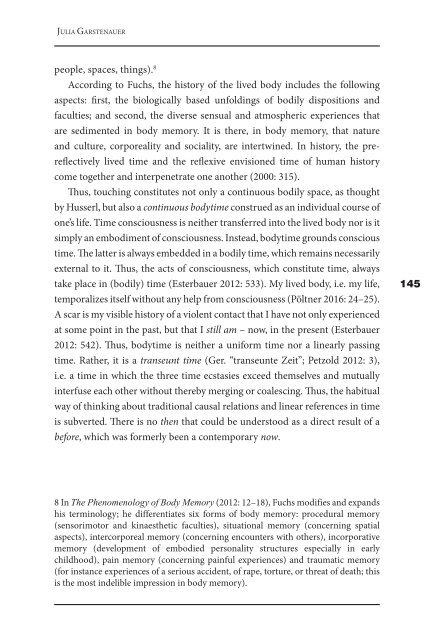phainomena
PHAINOMENA-98-99_e-verzija
PHAINOMENA-98-99_e-verzija
You also want an ePaper? Increase the reach of your titles
YUMPU automatically turns print PDFs into web optimized ePapers that Google loves.
JULIA GARSTENAUER<br />
people, spaces, things). 8<br />
According to Fuchs, the history of the lived body includes the following<br />
aspects: first, the biologically based unfoldings of bodily dispositions and<br />
faculties; and second, the diverse sensual and atmospheric experiences that<br />
are sedimented in body memory. It is there, in body memory, that nature<br />
and culture, corporeality and sociality, are intertwined. In history, the prereflectively<br />
lived time and the reflexive envisioned time of human history<br />
come together and interpenetrate one another (2000: 315).<br />
Thus, touching constitutes not only a continuous bodily space, as thought<br />
by Husserl, but also a continuous bodytime construed as an individual course of<br />
one’s life. Time consciousness is neither transferred into the lived body nor is it<br />
simply an embodiment of consciousness. Instead, bodytime grounds conscious<br />
time. The latter is always embedded in a bodily time, which remains necessarily<br />
external to it. Thus, the acts of consciousness, which constitute time, always<br />
take place in (bodily) time (Esterbauer 2012: 533). My lived body, i.e. my life,<br />
temporalizes itself without any help from consciousness (Pöltner 2016: 24–25).<br />
A scar is my visible history of a violent contact that I have not only experienced<br />
at some point in the past, but that I still am – now, in the present (Esterbauer<br />
2012: 542). Thus, bodytime is neither a uniform time nor a linearly passing<br />
time. Rather, it is a transeunt time (Ger. “transeunte Zeit”; Petzold 2012: 3),<br />
i.e. a time in which the three time ecstasies exceed themselves and mutually<br />
interfuse each other without thereby merging or coalescing. Thus, the habitual<br />
way of thinking about traditional causal relations and linear references in time<br />
is subverted. There is no then that could be understood as a direct result of a<br />
before, which was formerly been a contemporary now.<br />
145<br />
8 In The Phenomenology of Body Memory (2012: 12–18), Fuchs modifies and expands<br />
his terminology; he differentiates six forms of body memory: procedural memory<br />
(sensorimotor and kinaesthetic faculties), situational memory (concerning spatial<br />
aspects), intercorporeal memory (concerning encounters with others), incorporative<br />
memory (development of embodied personality structures especially in early<br />
childhood), pain memory (concerning painful experiences) and traumatic memory<br />
(for instance experiences of a serious accident, of rape, torture, or threat of death; this<br />
is the most indelible impression in body memory).


